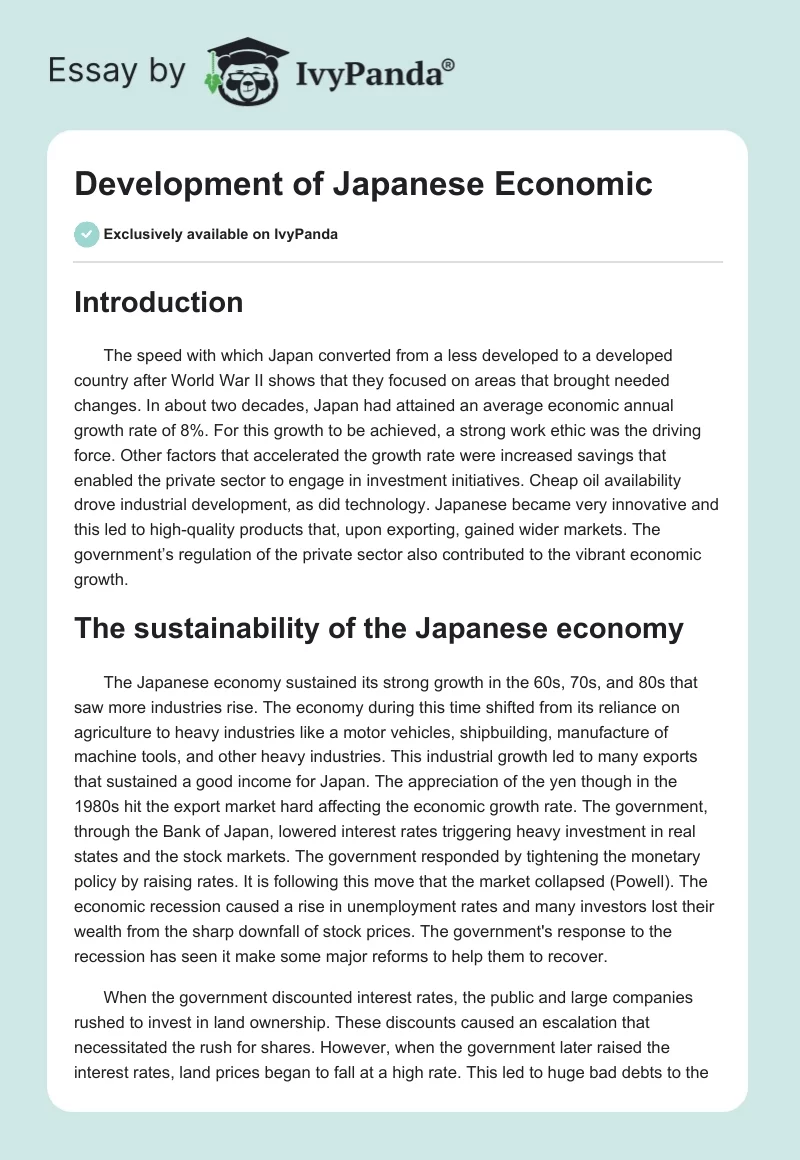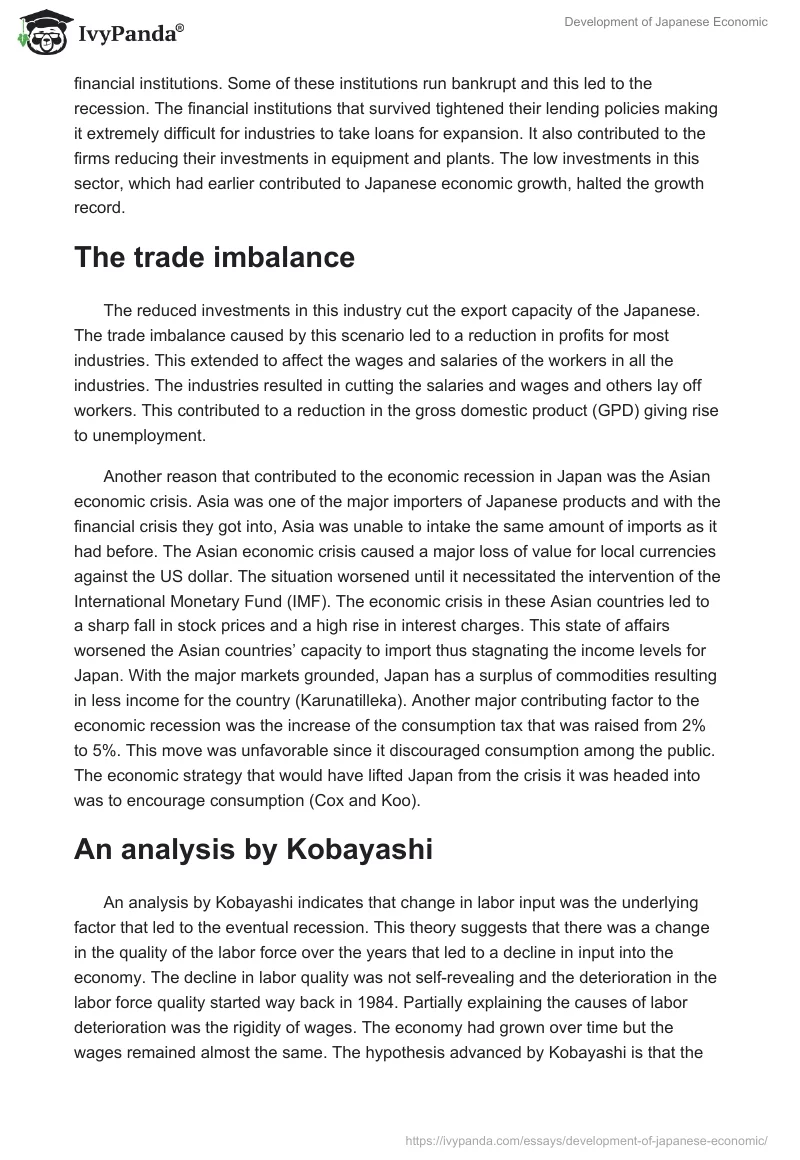Introduction
The speed with which Japan converted from a less developed to a developed country after World War II shows that they focused on areas that brought needed changes. In about two decades, Japan had attained an average economic annual growth rate of 8%. For this growth to be achieved, a strong work ethic was the driving force. Other factors that accelerated the growth rate were increased savings that enabled the private sector to engage in investment initiatives. Cheap oil availability drove industrial development, as did technology. Japanese became very innovative and this led to high-quality products that, upon exporting, gained wider markets. The government’s regulation of the private sector also contributed to the vibrant economic growth.
The sustainability of the Japanese economy
The Japanese economy sustained its strong growth in the 60s, 70s, and 80s that saw more industries rise. The economy during this time shifted from its reliance on agriculture to heavy industries like a motor vehicles, shipbuilding, manufacture of machine tools, and other heavy industries. This industrial growth led to many exports that sustained a good income for Japan. The appreciation of the yen though in the 1980s hit the export market hard affecting the economic growth rate. The government, through the Bank of Japan, lowered interest rates triggering heavy investment in real states and the stock markets. The government responded by tightening the monetary policy by raising rates. It is following this move that the market collapsed (Powell). The economic recession caused a rise in unemployment rates and many investors lost their wealth from the sharp downfall of stock prices. The government’s response to the recession has seen it make some major reforms to help them to recover.
When the government discounted interest rates, the public and large companies rushed to invest in land ownership. These discounts caused an escalation that necessitated the rush for shares. However, when the government later raised the interest rates, land prices began to fall at a high rate. This led to huge bad debts to the financial institutions. Some of these institutions run bankrupt and this led to the recession. The financial institutions that survived tightened their lending policies making it extremely difficult for industries to take loans for expansion. It also contributed to the firms reducing their investments in equipment and plants. The low investments in this sector, which had earlier contributed to Japanese economic growth, halted the growth record.
The trade imbalance
The reduced investments in this industry cut the export capacity of the Japanese. The trade imbalance caused by this scenario led to a reduction in profits for most industries. This extended to affect the wages and salaries of the workers in all the industries. The industries resulted in cutting the salaries and wages and others lay off workers. This contributed to a reduction in the gross domestic product (GPD) giving rise to unemployment.
Another reason that contributed to the economic recession in Japan was the Asian economic crisis. Asia was one of the major importers of Japanese products and with the financial crisis they got into, Asia was unable to intake the same amount of imports as it had before. The Asian economic crisis caused a major loss of value for local currencies against the US dollar. The situation worsened until it necessitated the intervention of the International Monetary Fund (IMF). The economic crisis in these Asian countries led to a sharp fall in stock prices and a high rise in interest charges. This state of affairs worsened the Asian countries’ capacity to import thus stagnating the income levels for Japan. With the major markets grounded, Japan has a surplus of commodities resulting in less income for the country (Karunatilleka). Another major contributing factor to the economic recession was the increase of the consumption tax that was raised from 2% to 5%. This move was unfavorable since it discouraged consumption among the public. The economic strategy that would have lifted Japan from the crisis it was headed into was to encourage consumption (Cox and Koo).
An analysis by Kobayashi
An analysis by Kobayashi indicates that change in labor input was the underlying factor that led to the eventual recession. This theory suggests that there was a change in the quality of the labor force over the years that led to a decline in input into the economy. The decline in labor quality was not self-revealing and the deterioration in the labor force quality started way back in 1984. Partially explaining the causes of labor deterioration was the rigidity of wages. The economy had grown over time but the wages remained almost the same. The hypothesis advanced by Kobayashi is that the fall in shares and land prices worsened the labor market with the impact being felt in the form of collateral constraints. This caused a decrease in consumption eventually leading to a decrease in labor input. This worsened an already bad economic situation.
Japan had in the periods leading to the recession progressively instituted quite a several hidden laws to control imports. The move was aimed at keeping off foreign competition. Such laws and regulations led to internal conflict since some people still intended to expand the import sector. Unnecessary restrictions being imposed on the industries contributed to this strife. Any market that closes itself to competition exposes itself to inefficiencies since the labor force will not be innovative enough.
The US overtaking Japan
The other contributing factor to the economic recession was the laws enacted that made it difficult to start new businesses. These laws also highly discouraged price competition. Interference with prices in form of price control is an interference with the normal market forces of demand and supply. Allowing an economy to have prices determined by market forces enables the economy to drop failing businesses and adopt upcoming ones. This scenario led to the US overtaking Japan in computer technology, a position Japan had prided itself in.
The banking sector is blamed mostly for its inflexibility in lending. Banks own most company’s shares in Japan and certain business groups own them. This setup influenced the lending policies of the banks. The period leading to the economic recession was occasioned by the banking industry only lending to particular big firms. The new firms that were just entering the market rarely had enough funding for expansion and suppressing these firms in part contributed to the economic downfall. The economy failed to fund firms that had the potential to fetch income for the Japanese. Japan had adopted restrictive policies that had led to the gradual growth of the economy. But upon reaching the peak, the policies to foster growth were still in place and Japan failed to adopt new policies for expansion. By expansion, the Japanese economy had to open up to new technologies and had to open up its market to foreign competition.
Conclusion
Many reforms have been proposed and are underway to revive the Japanese economy to make it a leader as it was before. The reforms have had mixed effects, at times positive indications of recovery appear and other times the economy falls into recession. These reforms are mainly targeted at the financial sector and the labor market where employment terms are being changed. This is to motivate innovation in the labor force to enable Japan to compete with foreign markets.
References
Cox, Michael W, and Koo, Jahyeong. “Miracle to Malaise: What’s Next for Japan?” Economic Letter Vol 1, 1 (2006). Web.
“Economy: Japan’s Economy Enters an Era of Globalization.” Japan Access. 2007. Web.
Karunatilleka, Eshan. “The Asian Economic Crisis.” Economic Policy And Statistics Section, House of Commons Library. 2007. Web.
Kobayashi, Keiichiro. “What Were the Causes of Japan’s Lost Decade?” Research Institute of Economy, Trade, and Industry. 2005.
Powell, Benjamin. “Explaining Japan’s Recession” Journal of Austrian Economics. Vol 5, 2 (2002).


